 News
News
ATTENTION
The recommended way to install the 12VHPWR (PCIe 5.0) cable
For PCIe Gen 5 new interface 12VHPWR, it’s a brand-new connector type with a 12-pin and a 4-pin
on it. FSP would like to share a recommended way how to connect a 12VHPWR cable and make sure
the cable is connected correctly and safely.
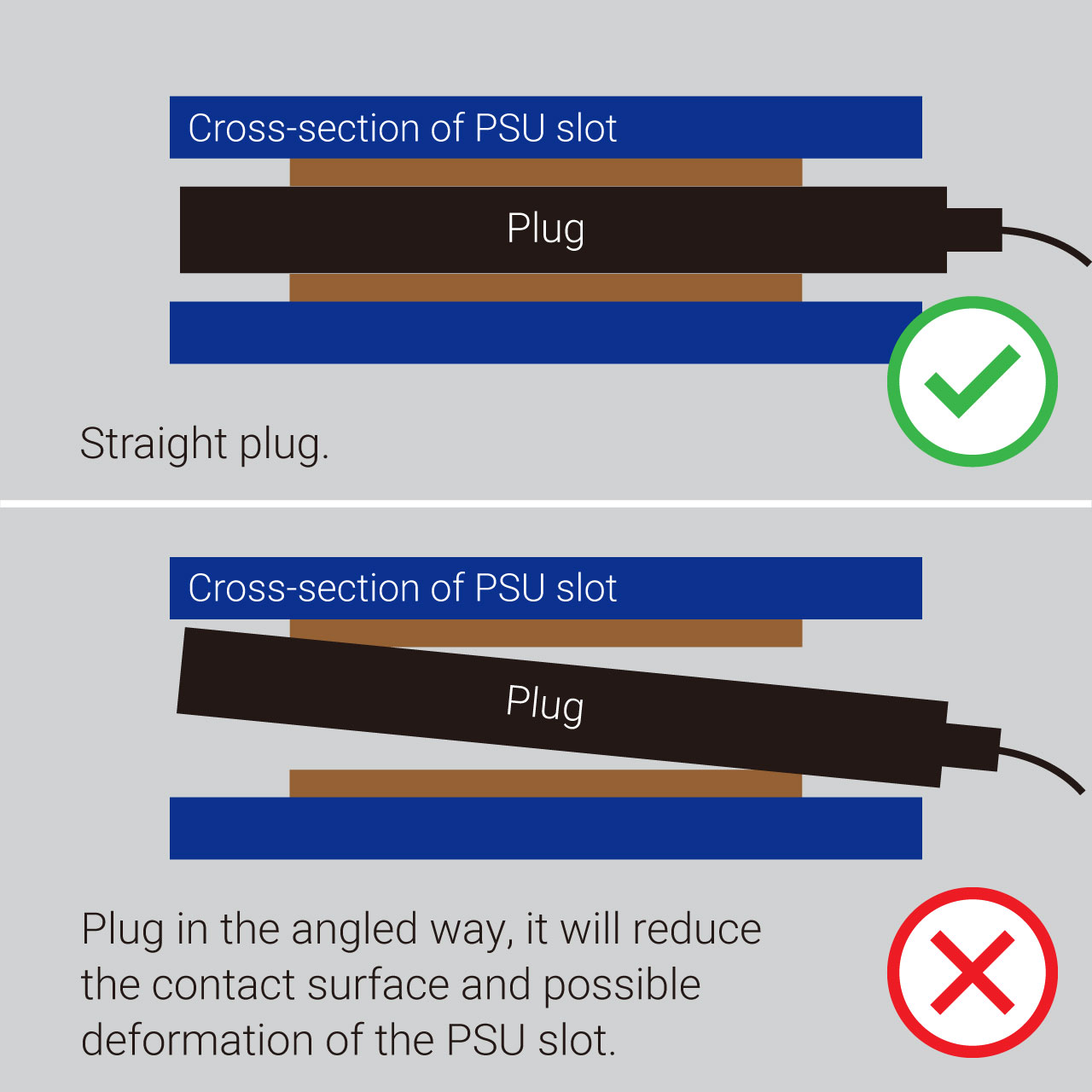
* Unbalanced plug-in contacts with the PSU slot surface, there is possible deformation of the PSU slot.
Attention: When plugging or unplugging, do not pull the wire, please plug or unplug with the connector directly.
The correct way to do cable management: Leave enough space for 12VHPWR cable
Do not recommend doing cable management on 12VHPWR cable as below.
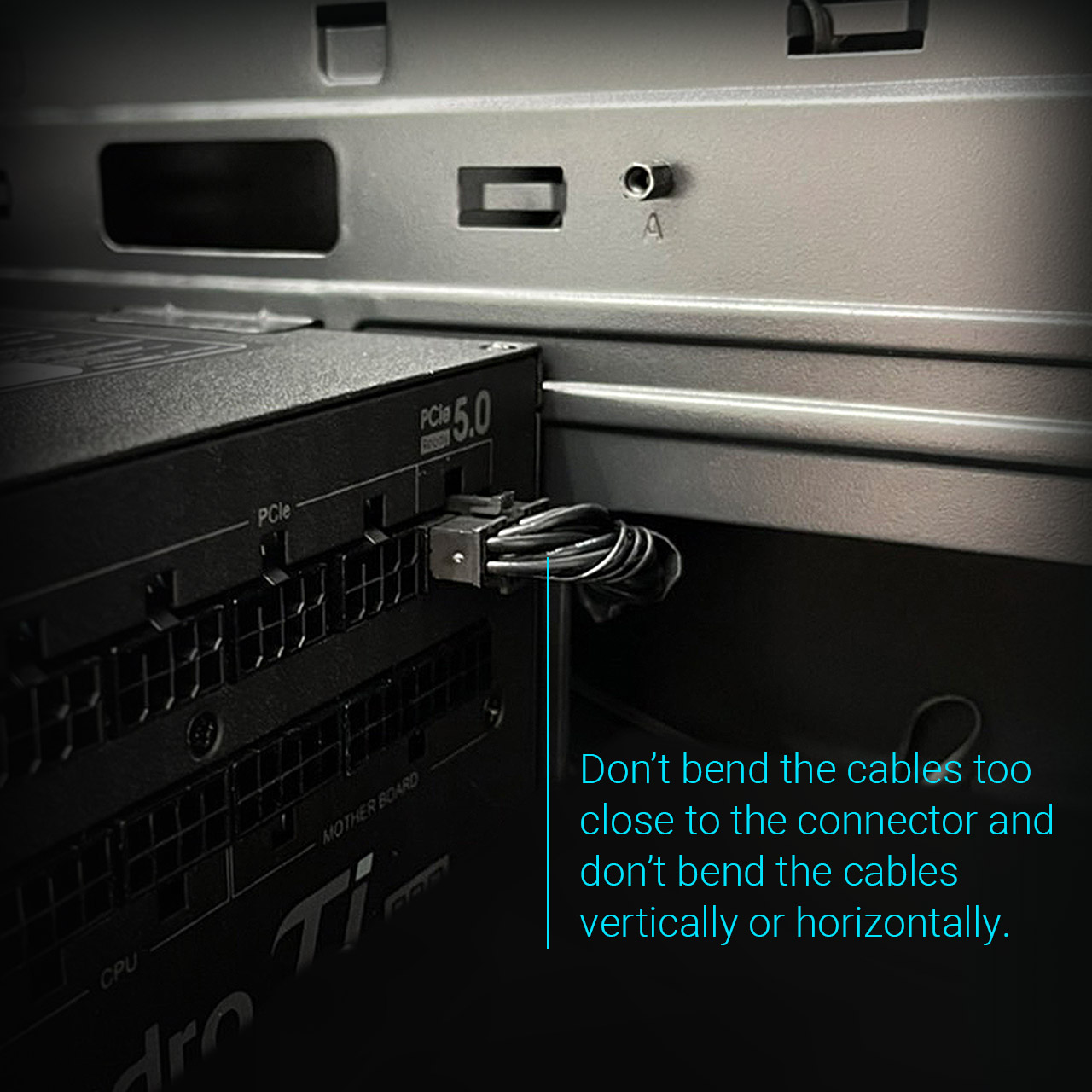
The recommended way to connect the 12VHPWR cable is like this.
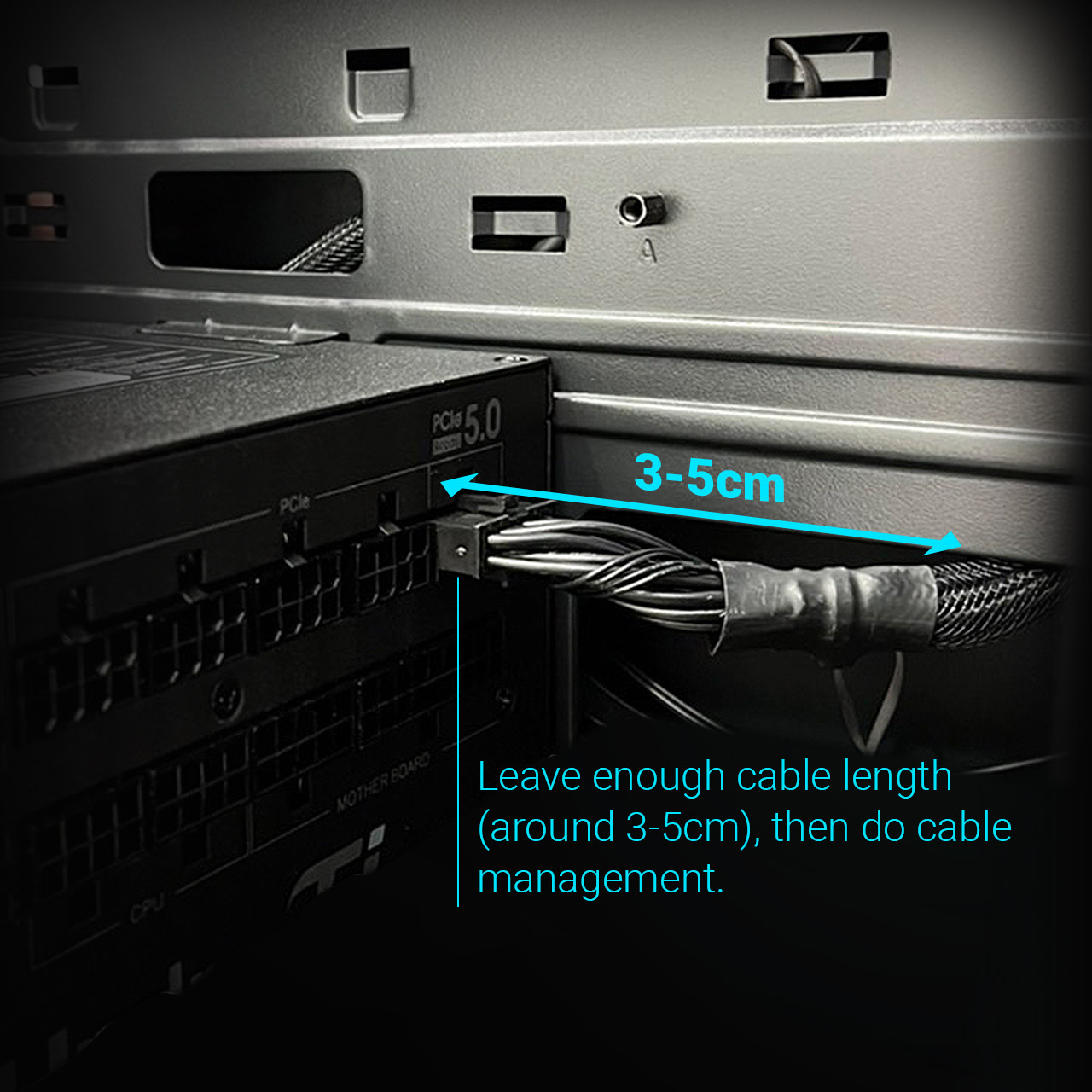
The size of RTX40 series graphic cards is larger than the previous generation. Please make sure the width of your pc case with enough space for PSU and RTX40 series graphic card.
Do not occupy the space of PSU cables(including the space to do cable management) to avoid any possibility of deformation of PSU slot.

Simple to know the correct way to do cable management.
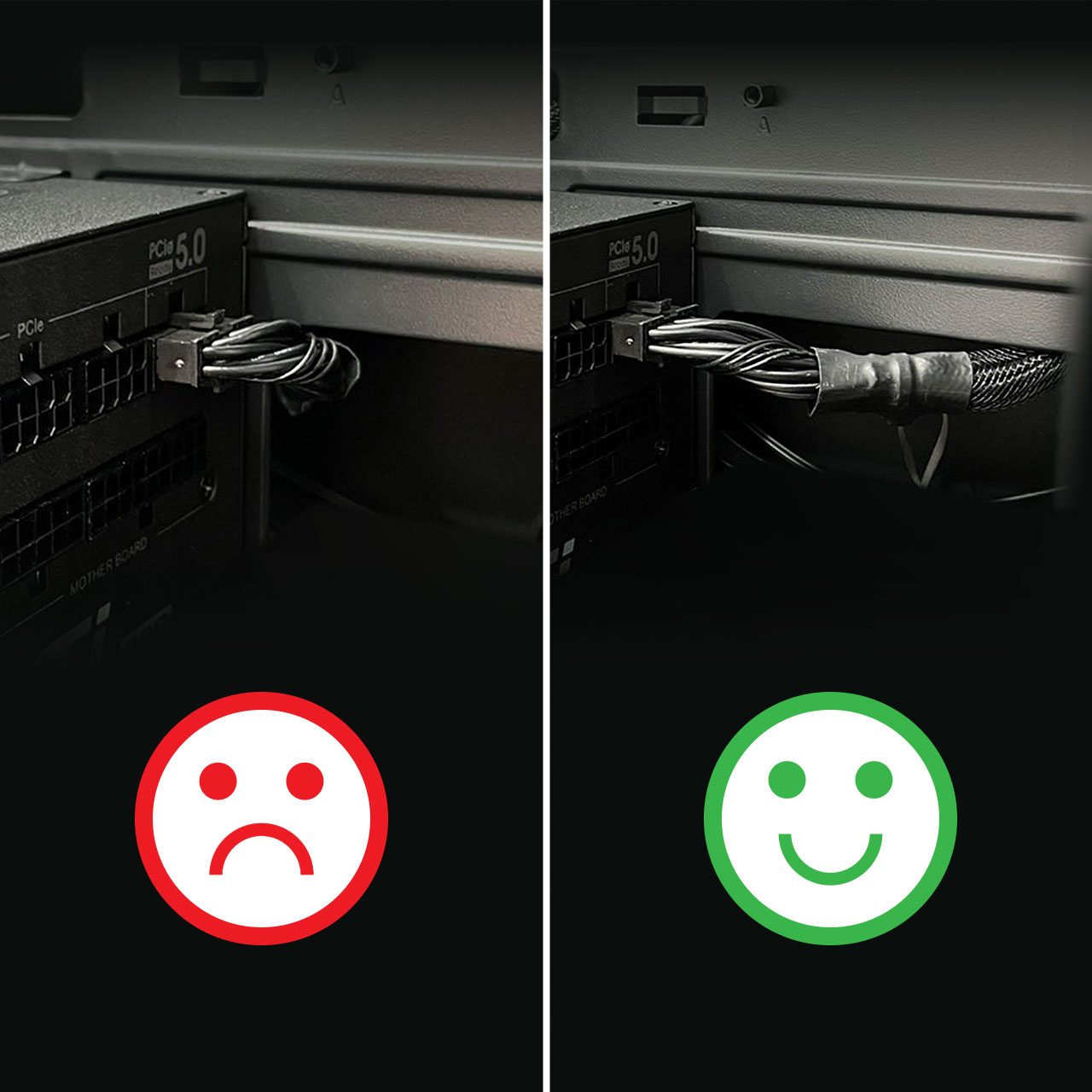
Have a good time while building a PC and playing a good game, power never ends.
Disclaimer
The FSP 12+4Pin (12VHPWR) cables are compatible with FSP power supplies only.
----------------------------------------------------------------------------------------------------------------------------------------------------
How to Choose an AI Server Power Supply Unit (PSU)? AI Server Power Supply Solutions
Overviews
- What is an AI server?
- Why do we need AI servers? Applications of AI servers
- Differences between AI servers and general servers
- Advantages and prospects of AI servers
- The importance of AI server power supply (wattage, stability, reliability)
- How to choose an AI server PSU?
- FSP AI server power supply solutions
With the rapid development and widespread adoption of AI technology, the server market has undergone significant changes in recent years. The launch of OpenAI's ChatGPT has sparked a trend in language models and intelligent chatbots. The computation behind ChatGPT relies on powerful "AI servers," which has brought attention to the AI server market.
What is an AI server?
An AI server is a specially designed and optimized server that may have one or more high-performance GPUs (Graphics Processing Units) or dedicated AI accelerators, such as Google's Tensor Processing Units (TPU) or NVIDIA's AI accelerator cards, among others. These hardware components provide a significant amount of parallel processing power for AI applications. Software is also a crucial component of AI servers. This may include operating systems optimized for AI and machine learning workloads, as well as libraries and tools that support AI frameworks like TensorFlow, PyTorch, and others.
Why do we need AI servers? Applications of AI servers
We need AI servers because the computational demands of AI are extremely high. AI servers offer specially optimized hardware and software for storing and processing vast amounts of data, thus supporting the training and execution of AI models. The applications of AI servers are very diverse, including image and voice recognition, natural language processing, predictive analytics, personalized recommendation systems, autonomous driving (image recognition), and the medical field (intelligent diagnosis), among others.
Differences between AI servers and general servers
The main differences between AI servers and general servers lie in their design and intended use. General servers are primarily used for data storage, running applications, and providing network services. Their design aims for efficiency, high stability, and reliable data storage. They have strong capabilities in data transmission and control, but they have fewer computational units because they operate at slower speeds.
In contrast, AI servers significantly emphasize a higher number of computational units and are specifically designed for running machine learning and deep learning workloads. The ability to parallel process data is crucial for training neural network models and performing rapid matrix multiplications. In summary, AI servers have more powerful computational capabilities and faster data processing speeds compared to general servers. Efficient data processing means there is no latency in data transmission. For applications like AR/VR, even slight delays can greatly affect the user experience. For autonomous driving, any delay in data transmission or insufficient computational speed may raise safety concerns and is not tolerable.
Advantages and prospects of AI servers
With the demand for emerging technologies such as VR/AR, ultra-high resolution, and autonomous driving, the world is currently in the era of a significant increase in data volume. According to IDC statistics, global cloud data has grown from 4.4ZB in 2013 to over 50ZB by 2023, a growth of more than tenfold. With the rapid growth of global cloud data, AI servers that excel at simultaneously processing large amounts of data and serving as fundamental equipment for storing vast amounts of data are destined to become a battleground for various industries. However, the PSU within AI servers is a crucial component that affects the performance of AI servers. This is because the hardware components inside AI servers have significantly higher power demands compared to regular servers. Therefore, the PSU inside an AI server must supply more power than regular servers to drive these high-performance components, while also ensuring sufficient redundant power to handle load variations and prevent data congestion.
The importance of AI server power supply (wattage, stability, reliability)
To understand how to select a suitable AI server PSU, one must first grasp its fundamentals. For dependable operation, AI servers rely on robust and stable PSUs. The PSU serves as a vital component responsible for converting alternating current (AC) from the electrical grid into the direct current (DC) necessary for the server's electronic components. In the context of high-performance AI servers, the PSU must deliver both ample and stable power to drive CPUs, GPUs, or AI accelerators. Additionally, PSU efficiency is crucial, as it directly influences overall energy consumption and heat dissipation requirements. A highly efficient PSU can minimize energy waste and reduce the demand for heat dissipation, ensuring server stability during high-load operations. Moreover, an efficient PSU can extend its lifespan and mitigate server downtime resulting from power-related issues.
How to choose an AI server PSU?
After understanding the importance of an AI server PSU, let's now explore how to select a good PSU. First and foremost, ensure that it provides sufficient power to meet the demands of all hardware components to prevent any power fluctuations or interruptions that could lead to system failures. Secondly, check the PSU's efficiency and stability. Lastly, ensure that the power supply unit has robust protection features such as overcurrent protection (OCP), over temperature protection (OTP), and over voltage protection (OVP). These three protection features are built-in safety measures of the PSU designed to prevent hardware damage and ensure system stability. Among them, OCP shuts down or limits the power supply unit when the output current exceeds limits to prevent hardware damage. OTP automatically shuts down the PSU when the internal temperature becomes excessively high to prevent overheating. OVP functions to shut down or limit the PSU when the output voltage exceeds limits to safeguard hardware from high voltage damage.
FSP AI server power supply solutions
Considering these requirements, FSP has introduced a series of AI server PSUs, with the most representative being the FSP3000-20FE. This product features extremely low total harmonic distortion (iTHD), an operating temperature range of 0 to 55°C, and is designed to operate at altitudes of up to 5,000 meters, providing a total power capacity of up to 3,000 watts. In other words, even in harsh and extreme environments, this product can continue to perform, showcasing its strong adaptability. Moreover, this product incorporates circuit protection designs, including OCP, OTP, and OVP, along with output short-circuit protection and a resettable power shut-off feature that allows it to communicate with the motherboard, ensuring reliable safety. With these protections in place, concerns about overheating or system failures due to excessive loads are a thing of the past. For AI servers, FSP has also introduced several excellent products, such as the YSEC1600AM-2A00P10 and YSEC2000AM-2A00P10. These are specialized PSUs for AI servers, boasting 80 PLUS® Platinum certification with an efficiency rating of up to 94% and built-in PMBus 1.2 technology. Their advantage lies in their compact size, making them suitable for installation in edge computing devices. Furthermore, due to their high conversion efficiency and excellent heat dissipation performance, they ensure stable operation of both the PSU and edge computing devices during long-term usage.
In the future, with the further development of edge computing and AI technology, the demand for these hardware components will continue to rise. Among them, AI servers and their PSUs will play increasingly important roles in the future. Choosing the right PSU ensures not only the smooth operation of AI servers but also provides assurance for the ongoing development and innovation of AI applications.
Know more about edge computing applications
----------------------------------------------------------------------------------------------------------------------------------------------------
FSP, the Top Brand of Power Supply in Five Application Fields
-Edge Computing/Medical/Smart Energy/Gaming/PD Charger-
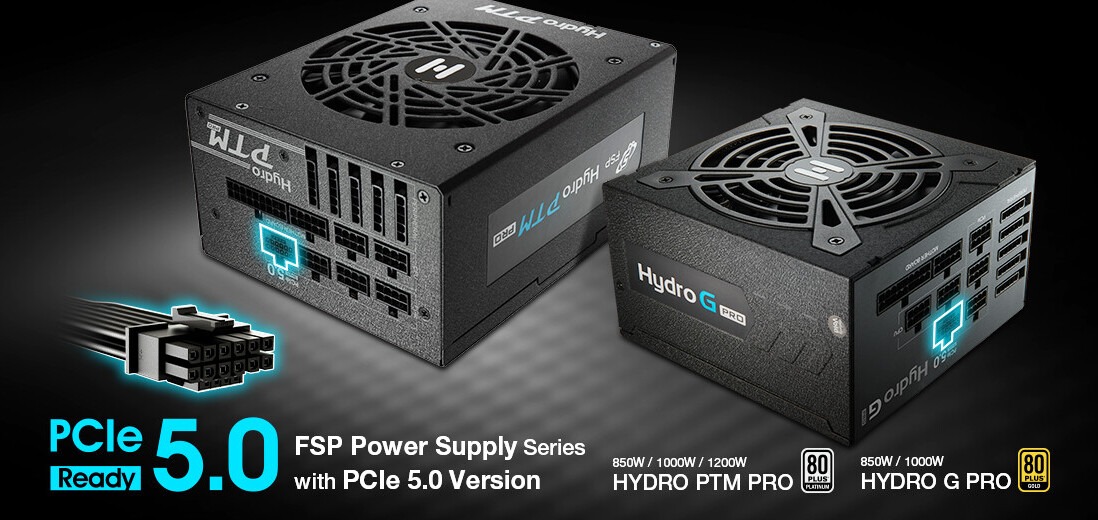
story in 2022 by introducing innovative power supply solutions with reinforced power delivery technology, and next-level safety features. PSDG ATX3.0 is in compliance with the new power design specification update in 2022, which includes CPU 12V current configuration, peak load requirements, and other design specifications, FSP looks to collaborate with market leaders like Intel and AMD to make cohesive power units that supply the best power output to extract the maximum performance out of the latest processors. Additionally, FSP gaming-focused power supplies showcase the new PCIe Gen 5 supporting hardware with the latest power supplies carrying PCIe 12VHPWR cable, designed to output higher to cater to the latest high demand GPUs in the market.
More: https://www.fsp-group.com/en/microsite/gaming/index.html
FSP this year at COMPUTEX will also showcase PD Charger Application. The new PD Charger product series aims to provide a full range of wattages from 30-240W solution and includes wall-mounted and desktop, direct, and indirect reference standards and customized product plans in order to meet the needs of customers from different industries.
More: https://www.fsp-group.com/en/microsite/pd-charger/index.html
To conclude, FSP looks to dominate the market with innovative solutions that cater to a wide range of users. At COMPUTEX 2022 FSP Group announces intentions very clearly, to become the leading force of the global power supply industry for the years ahead and promises uncompromising, innovative solutions for the masses.
Related News
- Feb 24th, 2022 FSP Group Introduces HYDRO GT PRO Series Power Supplies (12)
- Jan 11th, 2022 FSP Launches New 2400W PSU to Address Bottlenecks in High-energy Computing (4)
- Nov 25th, 2021 FSP Group Launches the World's First SFX 12VO 750W Power Supply (15)
- Nov 23rd, 2021 FSP introduces U3 series adapter that's 50% smaller but just as efficient as the previous generation (6)
- Oct 25th, 2021 FSP Group Releases CRPS 2000W Power Supply for Datacenter Application (1)
- Aug 25th, 2021 FSP Announces Power Supply Lineup for Blockchain Applications (4)
- Oct 18th, 2021 FSP LightUp Giveaway: Win Cool Gaming Hardware and Steam Cards (8)
- Jun 28th, 2021 FSP Announces Dagger Pro SFX 750W, and 850W Power Supplies (8)
- Jul 28th, 2021 Intel Alder Lake-S to See Limited Launch of Enthusiast SKUs in 2021, Other Models Arrive 2022 (37)
- Jun 15th, 2021 FSP Announces U3 Power Adapters for Laptops, Mobile Workstation, and SFF Desktops (10)
For more product information, please visit:
FSP Group USA's official website: www.shopfsp.com/
FSP Group USA Brand Product website: www.fsplifestyle.com/us/
Facebook: www.facebook.com/FSPGroupUSA
YouTube: www.youtube.com/user/PowerNeverEnds
----------------------------------------------------------------------------------------------------------------------
About FSP
Founded in 1993 and one of the leading suppliers of power supply products in the world, FSP Group (3015: Taiwan) meets varied user demands in power supplies with its 400-person strong R&D team, robust production capacity, and comprehensive production lines. With more than 480 models certified to 80 PLUS standards, the world number one in 80 PLUS certifications, enables users to enjoy eco-friendly technologies by providing the best environmental protection and quality power supply products.
Sign up now to receive updates on our latest products and promotions.
SHOPPING
COMMUNITY
Copyright©2019 FSP GROUP USA, All Rights Reserved.
Privacy Notice - Terms of Use

